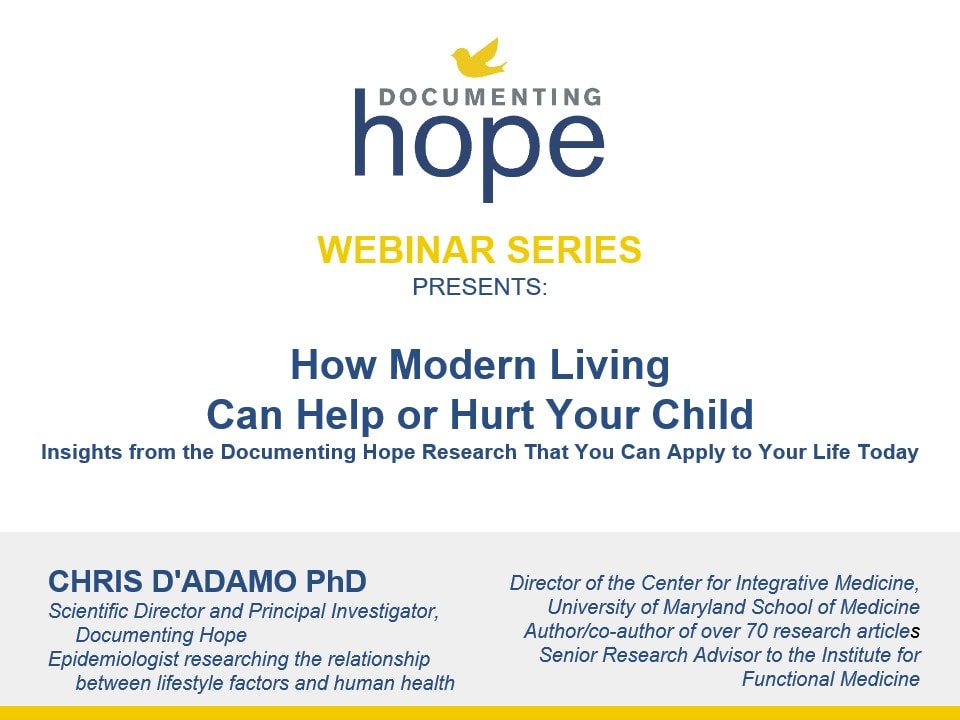What Is Total Load Theory?
Total load theory is a conceptual framework used to understand the synergistic and cumulative impact of many environmental and lifestyle stressors on an individual’s health. It posits that each individual stressor adds to the total “load” a body must manage over time. As a human body only has so many resources and only so much capacity to handle health stressors, there will be a point where the total load is too great, and this is when health symptoms typically emerge.
This theory serves as a unifying theory behind the growing rates of chronic illnesses in children in the modern industrial world. The total number of environmental, physical, biological, lifestyle and other types of health stressors that are experienced by modern children are substantially greater than any prior generation of children in human history. It is the cumulative and synergistic impact of living in the modern industrial world that has resulted in one of the greatest health crises of all time.
When children experience a total load of health stressors that is too great during their critical developmental windows (prenatally through the first 6 years of life), they may exhibit neurodevelopmental or neurobehavioral symptoms and often receive diagnoses like autism, ADHD or learning disabilities.
Cumulative Impact
The basic premise of the total theory is that the human body has a limited capacity to handle stressors. While a single stressor may not be sufficient to cause noticeable health issues, the cumulative and synergistic effect of many stressors over months and years can push the body beyond its capacity to adapt, resulting in illness or chronic symptoms.
These stressors are like drops of water filling up a barrel. From the time a child is conceived, he faces exposure to myriad negative health influencers that each represent drops of water in the barrel. With time, the barrel fills up and eventually overflows. When a child is exhibiting any kind of chronic symptoms (such as stimming, eczema, tantrums, allergies, chronic fevers and more) you can be sure that child’s barrel is too full.
What Are Common Stressors That Make Up Total Load?
The contributors to total load in today’s modern world are diverse and plentiful. Small daily exposures amass over time, pushing the body’s capacity to its limits and leading to a breakdown in health. Notable stressors include:
Physical Stressors
These personal lifestyle choices (what we eat, products we consume, activities we enjoy) and the way we live our lives in the modern world has an impact on health. Read more: The Cost of Modern Living. Physical stressors include:
- A processed-food, high-glycemic diet, which can lead to nutritional deficiencies, inflammation and microbiome imbalances
- Sedentary lifestyle, lack of natural movement
- Lack of natural light or too much artificial light
- Poor hydration
- Poor sleep
- Nature deficit or the ignoring of natural rhythms (e.g. circadian biology)
- Daily lifestyle stress or a stressful pace of life activities
- Parental stress, stress in the home, work stress
- Screen time
- Financial stress or poverty
Biological Stressors
These types of stressors put too much demand on the body’s resources and capacity to heal and can impede the natural healing process:
Environmental Stressors
Exposure to environmental toxins can significantly contribute to the total load. Toxins are in everything we consume from the air and water to food and medicine. Single stressors might not have profound effects on their own, but the cumulative burden of these toxins can overwhelm a child’s detoxification systems. Exposure to pesticides like glyphosate, chemicals in household products, and pollutants accumulate and strain the body’s detoxification processes. Toxins are in everything we consume from the air and water to food and medicine. Learn more about environmental toxicity. Examples include:
- Pesticides and herbicides
- Plastics
- Heavy metals
- Air pollutants
- Endocrine-disrupting chemicals
- Mold and mycotoxins
- EMFs
- Dirty electrical fields
- Chemicals in household products
- Synthetic fragrances
- Medications such as steroids, antihistamines, pain killers, antibiotics
- Poor lighting
- Excessive noise
Emotional Stressors
These types of stressors may be less tangible and harder to spot, but they can be a significant part of the total load for a child.
- Trauma, abuse
- Worries and fears
- Family dynamics
- Unrealistic expectations
- Past failure
- Lack of faith and spiritual support
- Bullying, social stress
- Generational trauma or harmful emotional patterns
- Lack of social connection, lack of friendships
- Financial stress or poverty
- Not feeling safe in an environment
Educational Stressors
Stressors at school can pile on to a child’s total load of stressors. Work with your child’s teachers and administrators to determine if any of these are affecting your child.
- Inappropriate curriculum
- Infrequent PE classes
- Infrequent or lack of recess or outside time
- Bullying
- Safety issues
- Overcrowding
- Non-ergonomic furniture
- Artificial lighting (e.g,. fluorescent or LED bulbs in a classroom)
- High levels of EMF in a building
Environmental health doctors have been talking about the total load theory for a very long time and often used it to describe the origins of autoimmune or mental health conditions. In the 2000’s, author Patricia Lemer first applied this concept to children with autism. See Ms. Lemer’s book Outsmarting Autism for more information.
More Than a Theory
When parents use the total load theory as a framework for helping their children overcome health and developmental issues, profound changes can occur. Documenting Hope published a case report in a peer reviewed journal of a family who helped their twin girls overcome their autism diagnosis by applying a total load lens to their children’s life. You can learn more about that case here.
All kinds of health conditions can be improved or overcome by using a total load lens: decreasing health stressors while increasing health supports. You can see many such cases in our database of success stories.
Adding in Supports Reduces Total Load
The other important feature of the total load theory is the role of health supports. While too many stressors can make a body sick, not enough health supports (what the body needs to function and survive) can also contribute to chronic conditions.
Our bodies are designed to heal, and they can, if we remove barriers to healing by removing stressors and adding in healing supports. Following are some ways to add health supports into your child’s life.
Support a Healthy Nervous System
The body cannot heal if it is in a state of fight or flight. It is our contention that most children (and adults) who have a chronic health condition are usually stuck in this stressful state, which can even affect a child’s development and neurodevelopment. Techniques that engage the vagus nerve—such as deep-breathing exercises, mindfulness, and time spent in nature—can help shift the body from this sympathetic state (figth, flight) to the more restful and healing parasympathetic mode.
Enhance Nutritional Support
Whole foods rich in vitamins and minerals can support the body’s natural healing processes. Traditional food preparation methods can enhance nutrient availability and digestibility.
Make Positive Dietary Changes
In general, children and adults cannot reverse a chronic health condition without making significant dietary changes. Eating a whole-foods diet that does not include added sugars is a critical step to healing, as this removes harmful many high-glycemic foods as well as harmful additives such as artificial and natural flavors, preservatives and artificial colors. A whole-foods diet will also have far more health-supporting vitamins and minerals than the Standard American Diet (SAD).
Many children can see profound health benefits by just switching to an unprocessed-foods diet. However, many will need to take it a step further by eliminating foods to which they have developed sensitivities. Most of these children may also need to implement a gut-healing diet and/or specialized diets such as a low-glutamate diet, ketogenic diet or low-histamine diet, among others.
Support Gut Health
The gastrointestinal tract is the seat of both the immune system as well as the manufacturing of nutrients and neurotransmitters that affect brain and body health. Gut function is determined by the quality of food as well as its microbial composition. Microbes within the gut can either help or harm health. Adding in a diverse variety of fiber-rich plant foods, phytonutrients, and fermented foods can significantly improve a child’s gut health by giving probiotic microbes the food they need to thrive while starving out pathogens. Specialized gut-healing diets such as the Paleo diet, the Body Ecology Diet, the Specific Carbohydrate Diet or the Gut And Psychology (GAPS) diet have all been used with great effect to reduce symptoms of chronic health conditions, including neurodevelopmental disorders.
Embrace Natural Rhythms
Aligning sleep patterns with natural light cycles can improve a child’s sleep quality. Ensuring that children get restful sleep, exposure to natural light, time outdoors in nature and physical activity can improve an overall feeling of wellbeing.
Create a Safe and Healing Environment
Creating a supportive and loving environment within yourself as a parent or caregiver as well as inside the home can boost your child’s resilience and self-esteem. Healthy relationships and psychological well-being are crucial for healing.
Create a safe space for a child to grow and develop by removing toxic products from the home and keeping a home free of EMF, wireless technologies (to the best of your ability) and synthetic items. Surround your family with natural furnishings (e.g. rugs and furniture made of wool, cotton or jute instead of synthetic fibers). Use natural, toxin-free products and opt for organic foods to minimize toxin exposure. Filter your house’s air and water.
Add in Restorative Therapies and Modalities
There are many therapies and healing modalities that can be used to restore health. Example of such therapies are numerous sensory therapies such as vision therapy, reflex integration, auditory therapy and others that can rewire the body and brain back together. Healing modalities include Traditional Chinese Medicine (TCM), naturopathic medicine, homeopathy, herbal medicine and homotoxicology, among others.
Breaking Down Total Load for Better Health
The total load theory emphasizes a paradigm shift from symptom-focused treatments to a holistic understanding of cumulative stressors. This theory provides a comprehensive lens through which the modern epidemic of chronic health conditions in children can be more effectively addressed. By recognizing and mitigating the various stressors from our environment, diet, and lifestyle, we can reduce total load, thus paving the way for healthier futures for our children. At the heart of it, our planet is sick, and so are the people who inhabit it. Read more: Sick Planet, Sick People.
Reducing total load and increasing health supports are essential for improving and maintaining children’s health. We advocate taking a detective approach to understanding each child’s specific stressors and supports. By doing so, interventions can be more personalized and effective.
Research Supporting Total Load Theory
Documenting Hope is dedicated to testing the total load theory in a rigorously scientific way. We have developed a research program to test whether reducing children’s total load by reducing stressors and adding supports can contribute to genuine health transformations.
About Beth Lambert
Beth Lambert is a former healthcare consultant and teacher. As a consultant, she worked with pharmaceutical, medical device, diagnostic and other health care companies to evaluate industry trends.
She is the author of A Compromised Generation: The Epidemic of Chronic Illness in America’s Children (Sentient Publications, 2010). She is also a co-author of Documenting Hope's Brain Under Attack: A Resource for Parents and Caregivers of Children with PANS, PANDAS, and Autoimmune Encephalitis. She is a co-author of Reversal of Autism Symptoms among Dizygotic Twins through a Personalized Lifestyle and Environmental Modification Approach: A Case Report and Review of the Literature, J. Pers. Med. 2024, 14(6), 641.

In 2009, Beth founded Documenting Hope and currently serves as Executive Director. Beth attended Oxford University, graduated from Williams College and holds a Masters Degree in American Studies from Fairfield University.
Still Looking for Answers?
Visit the Documenting Hope Practitioner Directory to find a practitioner near you.
Join us inside our online membership community for parents, Healing Together, where you’ll find even more healing resources, expert guidance, and a community to support you every step of your child’s healing journey.
Sources & References
Adams, J.B., et al. Mercury in first-cut baby hair of children with autism versus typically-developing children. Toxicological & Environmental Chemistry. 2007 Jun;70(12):1046-51.
Adams, J.B., et al. Mercury, Lead, and Zinc in Baby Teeth of Children with Autism Versus Controls. Journal of Toxicology and Environmental Health. 2007 Jun;70(12):1046-51.
Alampi, J.D., et al. Gestational Exposure to Toxicants and Autistic Behaviors using Bayesian Quantile Regression. Am J Epedemiol. 2021 Sep 1;190(9):1803-1813.
Aldad, T.S., et al. Fetal Radiofrequency Radiation Exposure From 800-1900 Mhz-Rated Cellular Telephones Affects Neurodevelopment and Behavior in Mice. Sci Rep. 2012;2:312.
Banks, W.A., et al. Aluminum-induced neurotoxicity: alterations in membrane function at the blood-brain barrier. Neurosci Biobehav Rev. 1989 Spring;13(1):47-53.
Beese, S., et al. Allostatic Load Measurement: A Systematic Review of Reviews, Database Inventory, and Considerations for Neighborhood Research. Int J Environ Res Public Health. 2022 Dec 18;19(24):17006.
Bernard, S., et al. Autism: a novel form of mercury poisoning. Med Hypotheses. 2001 Apr;56(4):462-71.
Bethell, C., et al. A National and State Profile of Leading Health Problems and Health Care Quality for US Children: Key Insurance Disparities and Across-State Variations. Academic Pediatrics, May–June 2011, Volume 11, Issue 3, Supplement, p. S22–S33.
Björvang, R.D., et al. Mixtures of persistent organic pollutants are found in vital organs of late gestation human fetuses. Chemosphere. 2021 Nov;283:131125.
Braun, J.M., et al. Association of Environmental Toxicants and Conduct Disorder in U.S. Children: NHANES 2001-2004. Environ Health Perspect. 2008 Jul;116(7):956-62.
Braun, J.M., et al. Exposures to environmental toxicants and attention deficit hyperactivity disorder in U.S. children. Environ Health Project. Dec 2006;114(12):1904-1909.
Choi, A.L., et al. Developmental Fluoride Neurotoxicity: A Systematic Review and Meta-Analysis. Environ Health Perspect. 2012;120(10).
Cohen, Patricia. Roundup Maker to Pay $10 Billion to Settle Cancer Suits. The New York Times. 24 Jun 2020.
Condon, E.M. Chronic Stress in Children and Adolescents: A Review of Biomarkers for Use in Pediatric Research. Biol Res Nurs. 2018 Oct;20(5):473-496.
Deisher, T.A., et al. Impact of environmental factors on the prevalence of autistic disorder after 1979. J Public Health and Epidemiology. Sep 2014;6(9):271-286.
Deth, R., et al. How environmental and genetic factors combine to cause autism: A redox/methylation hypothesis. Neurotoxicology. 2008;29(1):190-201.
Environmental Working Group. Body Burden: The Pollution in Newborns. 14 Jul 2005.
Geier, M.R., et al. The potential importance of steroids in the treatment of autistic spectrum disorders and other disorders involving mercury toxicity. Med Hypotheses. 2005;64(5):946-54.
Grandjean, P., et al. Developmental neurotoxicity of industrial chemicals. Lancet. 2006 Dec 16;368(9553):2167-78.
Guidi, J., et al. Allostatic Load and Its Impact on Health: A Systematic Review. Psychother Psychosom. 2021;90(1):11-27.
Gunatilake, S., et al. Glyphosate’s Synergistic Toxicity in Combination with Other Factors as a Cause of Chronic Kidney Disease of Unknown Origin. Int J Environ Res Public Health. 2019 Jul 31;16(15):2734.
Hansen, J.B., et al. Prenatal exposure to bisphenol A and autistic- and ADHD-related symptoms in children aged 2 and5 years from the Odense Child Cohort. Environ Health. 2021 Mar 12;20(1):24.
Hanson, D.R., et al. Theories of schizophrenia: a genetic-inflammatory-vascular synthesis. BMC Medical Genetics. 2005 Feb 11;6:7.
Harley, K.G., et al. Changes in Latina Women’s Exposure to Cleaning Chemicals Associated with Switching from Conventional to “Green” Household Cleaning Products: The LUCIR Intervention Study. Environ Health Perspect. 2021 Sep;129(9):97001.
Hauser, P., et al. Resistance to thyroid hormone: implications for neurodevelopmental research on the effects of thyroid hormone disruptors. Toxicol Ind Health. 1998 Jan-Apr;14(1-2):85-101.
Herbert, M.R., et al. Autism and environmental genomics. Neurotoxicology. 2006;27(5):671-84.
Herbert, M.R., et al. Autism and EMF? Plausibility of a pathophysiological link part I. Pathophysiology. 2013 Jul;1-19.
Herbert, M.R., et al. Autism and EMF? Plausibility of a pathophysiological link part II. Pathophysiology. 2013 Jun;20(3):211-34.
Hertz-Picciotto, I., et al. Organophosphate exposures during pregnancy and child neurodevelopment: Recommendations for essential policy reforms. PLoS Med. 2018 Oct 24;15(10):e1002671.
Hertz-Picciotto, I., et al. Polybrominated diphenyl ethers in relation to autism and developmental delay: a case-control study. Environ Health. 2011 Jan 5;10(1):1.
Hertz-Picciotto, I., et al. Prenatal exposures to persistent and non-persistent organic compounds and effects on immune system development. Basic Clin Pharmacol Toxicol. 2008 Feb;102(2):146-54.
Hinhumpatch, P., et al. Oxidative DNA damage and repair in children exposed to low levels of arsenic in utero and during early childhood: application of salivary and urinary biomarkers. Toxicol Appl Pharmacol. 2013;273(3):569-79.
Holmes, A., et al. Reduced Levels of Mercury in First Baby Haircuts of Autistic Children. International Journal of Toxicology. Jul-Aug 2003;22(4):277-85.
Jafari, M.H., et al. The Relationship Between the Level of Copper, Lead, Mercury and Autism Disorders: A Meta-Analysis. Pediatric Health, Medicine and Therapeutics. 21 Sep 2020(11):369—378.
Jafari, T., et al. The association between mercury levels and autism spectrum disorders: A systematic review and meta-analysis. J Trace Elem Med Biol. 2017 Dec;44:289-297.
Jedrychowski, W., et al. COGNITIVE FUNCTION OF 6-YEAR OLD CHILDREN EXPOSED TO MOLD-CONTAMINATED HOMES IN EARLY POSTNATAL PERIOD. PROSPECTIVE BIRTH COHORT STUDY IN POLAND. Physiol Behav. 2011 Oct 24; 104(5): 989–995.
Jett, D.A. Chemical toxins that cause seizures. Neurotoxicology. 2012 Dec;33(6):1473-5.
Johansson, O., et al. Exacerbation of demyelinating syndrome after exposure to wireless modem with public hotspot. Electromagn Biol Med. 2016;35(4):393-7.
Julvez, J., et al. Early life multiple exposures and child cognitive function: A multi-centric birth cohort study in six European countries. Environ Pollut. 2021 Sep 1;284:117404.
Juster, R.P., et al. Allostatic load biomarkers of chronic stress and impact on health and cognition. Neurosci Biobehav Rev. 2010 Sep;35(1):2-16.
Kern, J.K., et al. A biomarker of mercury body-burden correlated with diagnostic domain specific clinical symptoms of autism spectrum disorder. Biometals. 2010;23(6):1043-51.
Konkel, L. Phthalates and Autistic Traits: Exploring the Association between Prenatal Exposures and Child Behavior. Environ Health Perspec. 2020 Oct;128(10):104001.
Landrigan, P.J., et al. Children’s vulnerability to toxic chemicals: a challenge and opportunity to strengthen health and environmental policy. Health Aff. (Millwood). 2011 May;30(5):842-50.
Lanphear, B.P., et al. Low-level environmental lead exposure and children's intellectual function: an international pooled analysis. Environ Health Perspect. 2005;113(7).
Lathe, R. Environmental factors and limbic vulnerability in childhood autism; Clinical report. American Journal of Biochemistry and Biotechnology. 4 (2): 183-197, 2008.
Li, J., et al. Association between early life adversity and allostatic load in girls with precocious puberty. Psychoneuroendocrinology. 2023 Jun:152:106101.
Lombardi, C., et al. Residential proximity to pesticide application as a risk factor for childhood central nervous system tumors. Environ Res. 2021 Jun;197:111078.
Lueth, A.J. Allostatic Load and Adverse Pregnancy Outcomes. Obstet Gynecol. 2022 Dec 1;140(6):974-982.
Lyall, K., et al. Prenatal Serum Concentrations of Brominated Flame Retardants and Autism Spectrum Disorder and Intellectual Disability in the Early Markers of Autism Study: A Population-Based Case-Control Study in California. Environ Health Perspect. 2017 Aug 30;125(8):087023.
Malin, A.J., et al. Maternal Urinary Fluoride and Child Neurobehavior at Age 36 Months. JAMA Netw Open. 2024 May 1;7(5):e2411987.
Mathew, A. Allostatic Load in Cancer: A Systematic Review and Mini Meta-Analysis. Biol Res Nurs. 2021 Jul;23(3):341-361.
McEwen, B.S., et al. Stress, adaptation, and disease. Allostasis and allostatic load. Ann N Y Acad Sci. 1998 May 1:840:33-44.
Messer, A. Mini-review: polybrominated diphenyl ether (PBDE) flame retardants as potential autism risk factors. Physiol Behav. 2010 Jun 1;100(3):245-9.
Napoli, E., et al. Toxicity of the flame-retardant BDE-49 on brain mitochondria and neuronal progenitor striatal cells enhanced by a PTEN-deficient background. Toxicol Sci. 2013 Mar;132(1):196-210.
Osei, F., et al. Association of primary allostatic load mediators and metabolic syndrome (MetS): A systematic review. Front Endocrinol (Lausanne). 2022 Nov 22:13:946740.
Palmer, R.F., et al. Environmental mercury release, special education rates, and autism disorder: an ecological study of Texas. Health Place. 2006(12):203-209.
Palmer, R.F., et al. Proximity to point sources of environmental mercury release as a predictor of autism prevalence. Health and Place. 2009 Mar;15(1):18-24.
Parker, H.W., et al. Allostatic Load and Mortality: A Systematic Review and Meta-Analysis. Am J Prev Med. 2022 Jul;63(1):131-140.
Premji, S.S., et al. Prenatal allostatic load and preterm birth: A systematic review. Front Psychol. 2022 Oct 4:13:1004073.
Rauh, V.A., et al. Impact of prenatal chlorpyrifos exposure on neurodevelopment in the first 3 years of life among inner-city children. Pediatrics. 2006;118;e1845-1859.
Rowland, I.R., et al. Effects of diet on mercury metabolism and excretion in mice given methylmercury: role of gut flora. Archives of Environmental Health. Nov-Dec 1984;39(6):401-8.
Samsel, A., et al. Glyphosate, pathways to modern diseases II: Celiac sprue and gluten intolerance. Interdiscip Toxicol. 2013 Dec;6(4):159-84.
Samsel, A., et al. Glyphosate, pathways to modern diseases III: Manganese, neurological diseases, and associated pathologies. Surg Neurol Int. 2015 Mar 24;6:45.
Samsel, A, et al. Glyphosate’s suppression of cytochrome P450 enzymes and amino acid biosynthesis by the gut microbiome: Pathways to modern diseases. Entropy. 2013;15:1416–1463.
Seeman, T.E., et al. Price of adaptation--allostatic load and its health consequences. MacArthur studies of successful aging. Arch Intern Med. 1997 Oct 27;157(19):2259-68.
Song, Y., et al. Effects of acute exposure to aluminum on blood-brain barrier and the protection of zinc. Neurosci Lett. 2008 Nov 7;445(1):42-6.
Tang, J., et al. Exposure to 900 MHz electromagnetic fields activates the mkp-1/ERK pathway and causes blood-brain barrier damage and cognitive impairment in rats. Brain Res. 2015 Mar 19;1601:92-101.
Thompson, L., et al. What have birth cohort studies asked about genetic, pre- and perinatal exposures and child and adolescent onset mental health outcomes? A systematic review. Eur Child Adolesc Psychiatry. 2010;19(1):1-15.
U.S. Food and Drug Administration. FDA Issues Recommendations for Certain High-Risk Groups Regarding Mercury-Containing Dental Amalgam. 24 Sep 2020.
Wallinga, D., et al. Not So Sweet: Missing Mercury and High Fructose Corn Syrup. Institute for Agriculture and Trade Policy, Minneapolis, Minnesota. Jan 2009.
Wang, H.L., et al. Case-Control Study of Blood Lead Levels and Attention Deficit Hyperactivity Disorder in Chinese Children. Environmental Health Perspectives. 2008 Oct;116(10):1401-6.
Windham, G.C., et al. Autism Spectrum Disorders in Relation to Distribution of Hazardous Air Pollutants in the San Francisco Bay Area. Environmental Health Perspectives. 2006 Sep;114(9):1438-44.
Wong, S., et al. Autism, Mitochondria and Polybrominated Diphenyl Ether Exposure. CNS Neurol Disord Drug Targets. 2016;15(5):614-23.
Resources
Articles
The Environmental Working Group. Body Burden: The Pollution in Newborns. 14 Jul 2005.
Swan, Shanna, et al. Reproductive Problems in Both Men and Women Are Rising at an Alarming Rate: A likely culprit is hormone-disrupting chemicals. Scientific American, 16 Mar 2021.
Books
Fitzgerald, Randall. The Hundred-Year Lie: How to Protect Yourself from the Chemicals That Are Destroying Your Health. London: Plume, 2007.
Hong, Maria Rickert. Almost Autism: Recovering Children from Sensory Processing Disorder, A Reference for Parents and Practitioners. 2014.
Lambert, Beth. A Compromised Generation: The Epidemic of Chronic Illness in America's Children. Sentient Publications, 2010.
Lemer, Patricia S. Outsmarting Autism, Updated and Expanded: Build Healthy Foundations for Communication, Socialization, and Behavior at All Ages. North Atlantic Books, 2019.
Perro, Michelle, et al. What’s Making Our Children Sick?: How Industrial Food Is Causing an Epidemic of Chronic Illness, and What Parents (and Doctors) Can Do About It. Chelsea Green Publishing, 2017.
Rogers, Sherry. Detoxify or Die. Prestige Publishing, 2002.
Wachter, Kenneth W., et al. Offspring: Human Fertility Behavior in Biodemographic Perspective. National Academy of Sciences, 2003.
Videos
A Global Fertility Crisis – Dr. Shanna Swan
Websites
American Academy of Environmental Medicine (AAEM)







